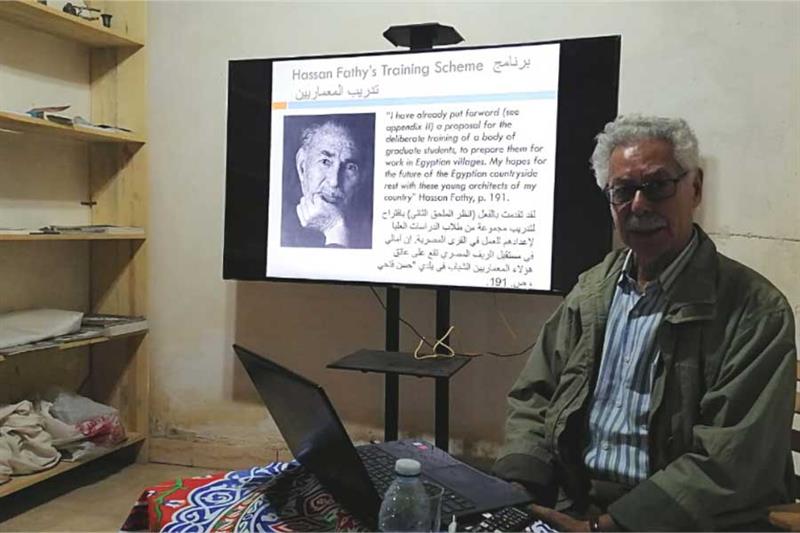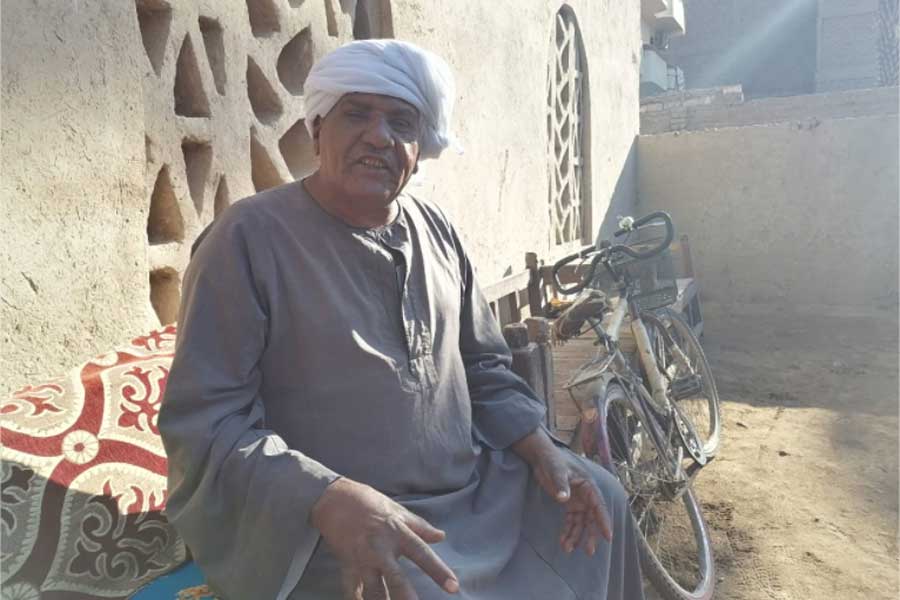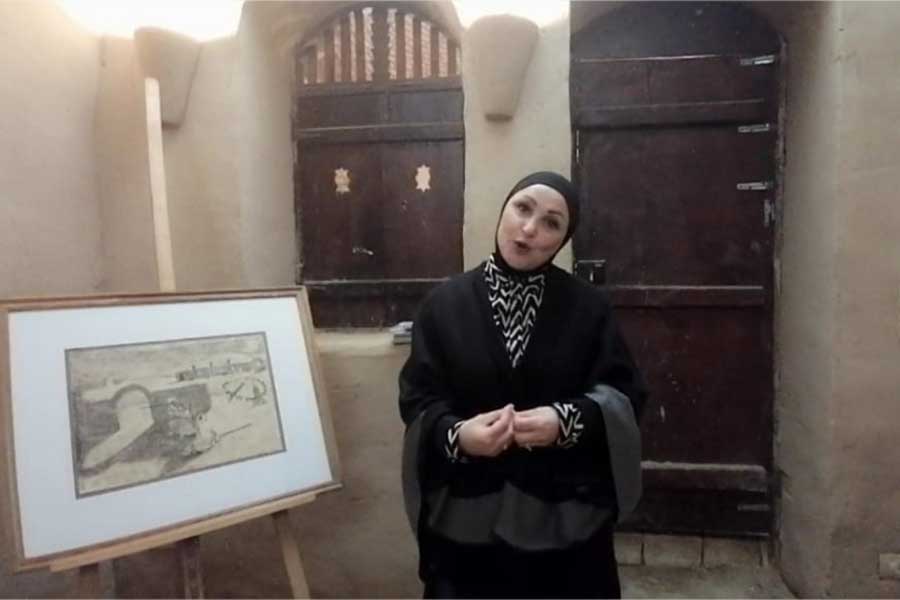'Every stone has a meaning': On Hassan Fathy, architecture, and New Gourna
Amira Noshokaty , Wednesday 12 Jan 2022

As the Egyptian Ministry of Culture and UNESCO celebrated their joint efforts to restore and safeguard the village of New Gourna on 23 December, stories of the brilliance and inspiration of late Hassan Fathy on the architectural and human levels were being retold.
Fathy (1900-1989) was an Egyptian, internationally renowned architect who was honoured and acknowledged worldwide. He won a gold medal from the World International Union of Architects (UIA) in 1984.
More than 33 years after his death, and over 70 years since he first established New Gourna, Fathy remains very much present at the premises of New Gourna village, the first of a kind eco-friendly green earth architecture that was founded between 1946 and 1952.
'Every stone has a meaning'
"You see architecture is one of the most authentic arts and is Egypt's specialty. The Arabs excelled in poetry, the Greeks in sculpture and the Egyptians in architecture. Ever since the ancient Egyptians, every stone has had a meaning," explained Fathy in one of his rare television interviews.
Fathy is best known for his book that continues to inspire generations, Architecture for the Poor, translated in 22 languages. The book documented his project to create a new residential village in Gourna area, away from the excavation and tombs, in the mid-1940s. Fathy's philosophy was not celebrated in his own country, and he faced many challenges at the time.
Bringing low-cost housing that is sustainable and eco-friendly to the market would have easily cracked the concrete construction business altogether. The fact that the relocation to New Gourna village was implemented by the government was not appealing to the people who lived near the excavation area at old Gourna all their lives. This led to the minimal occupation of the houses of New Gourna. However, Fathy was persistent and tried to attract the villagers through many ways.
The Oldest House in New Gourna
"I was born in Gourna mountain. My father worked with Hassan Fathy in 1946 and we moved from the mountains to the village where Hassan Fathy built us schools, a touristic souk, a trade souk and he even made a loom to move the tradespeople from the mountains," explained Ahmed Abdel-Radi, the owner of the oldest house in New Gourna.
"There was a school for girls, one for boys, and one for handicrafts. He built an open-air theatre, a mosque, a khan, a touristic market, and an annual trade market. In our old village, education was only for the rich, where the people would enrol their kids in schools on the eastern bank, so we used to learn how to read and write only in the kottab of the village. Hassan Fathy took us ahead a very big step, even the people who refused to move out of the mountain, because they did not like all the domes that resembled tombs, in their view, and the idea of granting their children school education would divert the children from aiding them in excavations. Hassan Fathy managed to get aid from UNICEF, so that each child who goes to school got a grant of flour, oil, milk. People started to enrol their children in schools that became full," Abdel-Radi told Ahram Online.

Abdel-Radi, owner of the oldest house in New Gourna
The construction of the village had been completed before Egypt built the Aswan High Dam, which led to the increase in the levels of underground water that immensely affected the foundations of the 70 houses that Fathy had built in the village.
People started to demolish the buildings fearing for their safety, others sought bigger space for their extended families. The result was that 65 out of the 70 houses were demolished. Then, Fekry Hassan started restoring the houses and what was left of Fathy's architecture, explained Abdel-Radi.
"Currently, we have a team and we build and train people how to build with mudbrick. I am not an architect, but I teach them the subjects that are not taught in universities, such as How to prepare the mud bricks, for they are a key element in decreasing the temperature from 43 degrees outside, to 22 degrees indoors, "added Abdel Radi.
'The City We Need Now- Gourna'
The premises of the Hassan Fathy Center for Architecture and Development in New Gourna is a vivid manifestation of his philosophy. Taking a tour guided by professor Fekry Hassan, the director of the centre, it was easy to note the connection between the green architecture and its modern functionality, a perfect example of how heritage meets modern functionality and solves its biggest eco problem.
"In February 2021, on the occasion of World Cities Day, the United Nations Human Settlements Programme, UN-Habitat, picked Luxor as a hosting city of this year's theme titled Architecture and Cities Facing Climate Change. In this theme, Hassan Fathy is the pioneer, so we held a seminar on this topic and a global initiative was launched on what kind of city we want to live in. Gourna is the place from which the global initiative kicked off and it was called: The City We Need Now -- Gourna," noted Hassan, director of Egypt's first higher education programme in culture heritage management at the French University in Egypt, and emeritus petrie professor of archaeology at the Institute of Archaeology, University College London.
"The Hassan Fathy Centre is a place where we adopt the ideas of Hassan Fathy and the philosophy and architecture that reflect his ideas in this village. I think we succeeded to a great extent in conveying this message and the visitors appreciate and understand the importance of his philosophy. He built for every family its own quarters and did it organically and with no intersecting lines, which gave a feeling of ease, because it reflects nature -- nothing in nature is a straight line -- so have curves, like domes," added Hassan.
"He built when there was no electricity in the 1940s in the village. He created a natural air-conditioner, using domes and adding malaaf hawa (where air is cooler), which decreases the temperature substantially in the house in the summer and in the winter the house becomes warmer. He used local raw materials, which meant less transportation. This is better for the environment, where less fuel is used and less emissions produced. He believed that the building is a home, not a house, it's a maskan, which in Arabic means a place to live and the root of the word, sakina, means serenity. That's why Fathy used this term to describe his housing philosophy," noted Hassan.
What's remarkable about Fathy is his human connection with the people of New Gourna: how he genuinely cared about their well-being; how he would stage plays to raise people's awareness about Schistosomiasis, a common poverty-related disease resulting from coming in contact with fresh water infested with larval forms of parasitic blood flukes.
"He would wear one of the old masks of World War I and play the role of the bad Mr Bel to raise the awareness of children and their parents," remembered Hassan, adding that Fathy designed a linen suit and soaked it in flax seed oil to make it impermeable, hence preventing Schistosomiasis from delving into fresh water.
Building prototypes in Spain and Latin America, and being awarded numerous architecture awards, Fathy keeps surprising us by planning ahead. In 2008, when 4,036 Palestinian houses in the Gaza Strip were demolished, the UN thought of building houses adopting Fathy's style, to be built from mud. It turned out that he had already designed a housing map for Gaza reconstruction since 1957, continued Hassan.
An artistic inspiration
Fathy also inspired the artists of his era. Among those who believed in his New Gourna and drew the people and the place is renowned Egyptian painter Mamdouh Ammar.
At the official celebration of the opening of New Gourna, a rare selection of paintings by Ammar were on display, handpicked and curated by his daughter-in-law, Abeer Helihal, in the presence of his daughter.
Ammar (1928-2012) was an Egyptian painter who spent his two years of artistic sabbatical in Luxor's Marsam in 1954, which was headed by Fathy. Ammar was inspired by Fathy and drew the women of Gourna and the place that inspired him to build his own house adopting the philosophy of Hassan Fathy while reflecting his own identity.
"Art is the most honest documentation of civilisation. To capitalise on that, the Ministry of Culture ought to create much more artistic sabbaticals, for artists to be free to create while sustaining a decent life. This is what Mamdouh Ammar had always called for," explained Helihal.

Helihal with one of the paintings of renowned painter Ammar
"When I open my window, the most beautiful thing my eyes see is the Dome of Kaienbey Al-Rammah, and every time I see it, I think to myself that no architect who graduated from any university in the world would be able to create something like that. Behind such piece of work is 500-600 years of heritage and handcraftsmanship that are guided by a Sufi man who is teaching them all about the words that adorn the dome because every stroke has a meaning, like the Pharaonic temples where every stone had a meaning, like the saying [of Antoine de Saint-Exupery] that every step in my father's house had a meaning, life back then also had a meaning," Fathy had said.
-- Sent from my Linux system.
No comments:
Post a Comment